
The real rose (Rosa damascena) is a symbol of love and has held a special place in people's hearts since ancient times until today. The name “Damask Rose”, which is based on the botanical name, refers to the geographical origin of our favorite flower, namely the Syrian capital Damascus.
Originally, the rose was used to extract fragrant oils that were needed for religious rituals. It later became widely used in medicine in various forms. Roses have been declared a sacred plant. In ancient Egypt, the rose replaced the color of the lotus as a sign of luxury and extravagance.
The poet Sappho calls the rose "the queen of flowers". Vishnu, the guardian of the universe, saw the fascinating beauty Lokshmi in a pink swing, woke her with a kiss and turned her into his wife. From that moment Lokshmi became a goddess of beauty, and the pink bud that hid her became the symbol of a divine secret.
The rose was the favorite flower of the David family, from which the Savior and His mother were descended. The virgins consecrated to God were called roses.
In the words of medieval Persian poets: “The rose is a gift from Allah. Once all the plants appeared to him with a request to give them a new manager instead of the sleepy lotus. The lotus was beautiful, but at night it forgot its duties as ruler. And then Allah graciously gave the plants a new ruler - a virgin rose with its sharp thorns for protection ".
The rose cult continued in the Orient. When Saladin conquered Jerusalem in 1187, he sent 500 camels with rose water to clean the Omar Mosque, a Muslim temple in Jerusalem.
Some historians believe that the crusader Robert de Brie brought the oily rose to Europe from Syria sometime between 1254 and 1276.
It is believed that the first roses reached what is now Bulgaria from the returning soldiers of Alexander the Great to Thrace. Written sources from the 1st century BC. testify to the role of roses in the life of the Thracians. There was also rose oil in the anointing oil for religious rituals.
The oily rose with a delicate pink color and intoxicating aroma, known as "Bulgarian rose", was only brought to Bulgaria in the Middle Ages. There are reliable sources about the presence of oil roses since 1652 in the region of the city of Kazanlak, now known as the Rose Valley. Roses were imported into these areas via Damascus. A Turkish judge planted roses in his garden at the time of the Ottoman Empire, whereupon Sultan Murad III ordered the judge to grow roses for the needs of the sultan's palace.
“Kazanlak” - writes Count Moltke (Prussian field marshal, in Turkish service from 1835 to 1840) - is the Turkish Gulistan. "In the fields, roses grow like potatoes".
The Rose Valley in Bulgaria has become the symbol of the country. The Bulgarian rose stands for the highest quality in the world. Valuable "liquid gold", namely essential oil and rose water from the rose blossoms, are extracted for perfumery, aromatherapy and cosmetics.
In ancient times, the rose was used in folk medicine to relieve coughs, treat abdominal pain and digestive problems, relieve menstrual cramps, and especially painful cramps.
Tea made from fresh or dried rose petals has a calming and relaxing effect and is used to help with acute stress, anxiety and depression and as a pleasant means to relax, unwind and improve sleep.
In Bulgarian folk medicine, rose petals are used as a laxative - the mild laxative effect of jam made from rose petals is well known. Furthermore, rose petals are used for gastrointestinal diseases and to regulate gastric secretion.